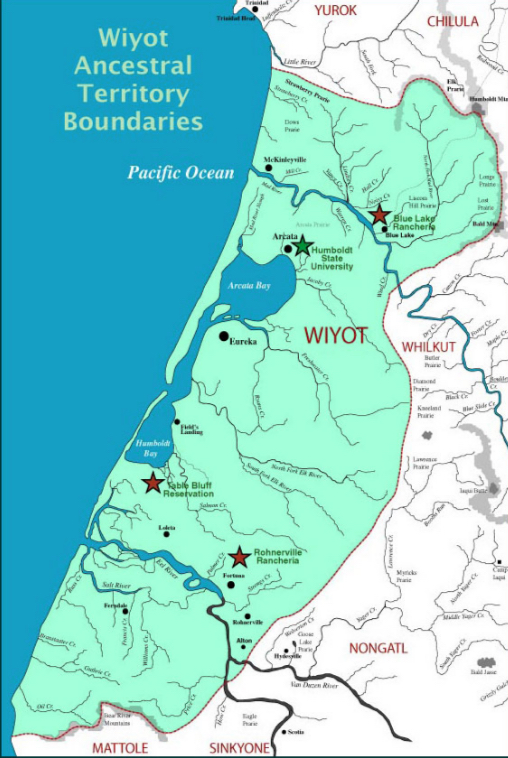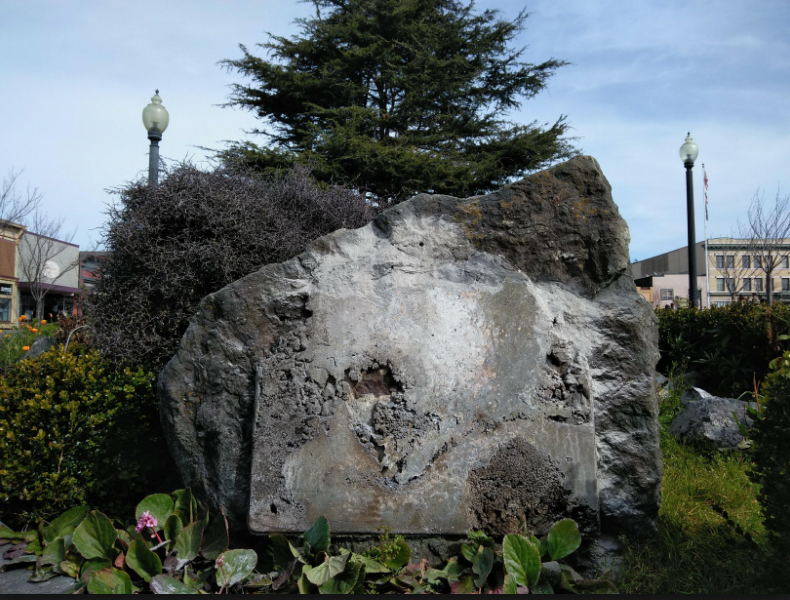Remove Mckinley Vote No on Measure M

courtesy of Mad River Union 
THE MCKINLEY STATUE SAGA
How did a statue of President McKinley end up in Arcata, California? Why is the removal of this statue so important? Our goal is to provide facts and a breadth of resources about this complex issue. This matter is now going to be voted on by Arcata residents in November 2018. It is our hope that after viewing the information contained in this website, Arcata residents will have the necessary information to make the choice to stand with Indigenous Peoples and people of color and vote to remove McKinley by voting NO on Measure M.

George Zehndner:
A Slave-Owning Member of the Wealthy Elite
As McKinley entered the Civil War in June of 1861, the one-day financier of the McKinley Statue, George Zehnder was in possession of a 7 year-old Indigenous slave renamed “Lucy”. Zehndner was 26 years old. Source.
Zehndner was not the only one. “In February 1861, the county judge of Humboldt County published a notice in a local paper complaining of the extra work thrown upon him by those desiring to have indenture papers drawn up” (below).
The McKinley statue was paid for in 1905 by an 81 year-old George Zehndner after a lifetime of amassing wealth-through-trespass in Humboldt County. This “simple farmer” paid $15,000 for the project, an equivalent to $415,303 (when adjusting for inflation). Source. How many of us today could pay cash for a similarly priced object while maintaining a comfortable lifestyle? This wealth was extracted from land that did not belong to him, his occupation was backed by the murderous authority of white settlers in Humboldt County.
“Just as white America never sustained any attempts at justice for the freed people and their descendants, there has never been a true public accounting of the history that took place around and against those nobly mounted men of bronze. Any argument to preserve them in their places of honor and prominence, however earnestly protective of “history,” must first acknowledge that their very presence served to help people not to remember but to forget. Until that forgetting is undone, they will never do anything else.” –B. Dueholm Source

There have been several efforts to remove the McKinley statue since the 1947. This is the first time the movement to remove the statue has been led by Indigenous Peoples.
WIYOT TRIBAL COUNCIL
Wiyot territory includes the city of Arcata. The Wiyot Tribal Council voted to support removal of the statue and wrote a letter attesting to their position. The Historic Justice Alliance stands in solidarity with the Wiyot Tribe and believes their vote should have been the end of matter. Leading up to and following the Wiyot Tribal Council’s decision, the Historic Justice Alliance and other community members were working to educate the Arcata City Council and the public as to why this symbol needed to be removed. The City of Arcata held a number of public meetings on this issue. People were afforded numerous opportunities to make their beliefs known, such as by speaking at meetings, emailing or calling city council members. On February 21, 2018, the city council voted 4 to 1 to relocate the statue from its current location at the plaza center.

The council’s decision to remove the statue demonstrated an attempt to align the city’s practices with its own Indigenous Peoples Day Proclamation (below).
Councilmember Susan Ornelas articulated her reasons for voting for removal.
In a press release from the city of Arcata, Mayor Sofia Pereira thanked the community for its extensive input on the matter:
“As a Council, we took on a difficult issue that has endured for decades in Arcata. Thank you to all the community members who took part in the Council’s decision-making process by voicing their opinions during our December study session, making phone calls, writing letters, signing petitions and engaging the Council at Wednesday’s meeting. I encourage all community members to continue to engage the Council and attend our monthly meetings on issues they feel strongly about. Since Arcata is on Wiyot land, I also want to extend gratitude to the Wiyot Tribe for offering their input on this important community matter.
The decision to remove these monuments was not made lightly, and the Council recognizes that this is still a passionate issue for many in our community. I stand by our vote as I believe that these monuments do not reflect our values as a community nor the values to which we aspire. We cannot deny or change the history behind these monuments, but we can change the prominence they hold in our community.”
Above: A gathering around the statue on the eve of the Arcata City Council vote to remove.
REASONS FOR REMOVAL
The reasons for the call to remove the statue are complex, are tied to global and local events, racism, genocide and the ideologies that drive them. The events span different and overlapping points in time to form a continuum. Ignoring the issues and taking the statue at face value is to ignore atrocities, a profound disservice to those effected.
This project reviews the specific actions that are tied to McKinley and which caused immense harm to real people. Also provided is information about the legacies tied to McKinley who changed the course of history for entire nations.
You cannot have domination of continents that are already occupied without force, murder, dispossession and systemic repression. One must expect the consequences of these tactics to last hundreds of years, at a minimum, and to be clearly evident in present-day conditions and government policies. They are. This project is meant to illustrate McKinley’s role in this.
At issue here is not just McKinley’s acts of global genocide (as defined by the UN-source) but the way it connects to the genocide of the Wiyot Peoples and other local Tribes. If your people and culture had endured destruction at the orders of a powerful leader or organized groups, would you stand idly by while a statue of this person was erected in your town square? What about a statue of someone who had been exemplary in perpetrating much the same thing? What would you make of assurances from others that this person was a champion of civil rights and was brave, while others told you to “get over it”? It is important that people examine their conditional emotions and opinions about these issues. What makes you care? What makes you undecided? It is important to ask yourself the reason for these biases.
SYMBOLS
“A statue is a symbol of what the establishment cherishes”
A. Pignataro
As written by Anthony Pignataro, “a statue is a symbol of what the establishment cherishes.” Further articulating this matter, B. Dueholm wrote, “The arch of Titus in Rome commemorates the destruction and despoiling of the temple of Jerusalem — a massive act of violence celebrated to display the power behind the violence. But, by now, no crime could be reassessed or redressed by pulling it down: It has become part of ancient history, which we preserve without prejudice to its meaning. Yet when Americans sympathetic to preserving the monuments of the Confederacy talk about preserving history, I can’t help but think about the history we have not taken any similar care to preserve, let alone celebrate.” Source.
Why write about statues of the Confederacy in a project about the McKinley statue?
Put simply, McKinley fought his hardest to enslave entire nations. He initiated U.S. slavery of several nations. If one reviews the information in this project, this becomes clear.
“President William McKinley is our Robert E. Lee to Pacific Islanders.”
Khara Jabola-Carolus, co-founder of AF3IRM Hawaii,
That the placement of the statue is in the center of Arcata-in a place of honor- is painfully ironic. Old-timey Arcata as a whole probably had little regard for what McKinley had done to entire nations of people but what of today? Even 154 years after the Wiyot Massacre, a simple apology cannot be put into words. Staff within the Eureka City government blocked a heartfelt letter of apology from Mayor Frank Jaeger out of an unfounded concern about liability. Source.
Below, the first letter written by Mayor Frank Jager:
Below, the final draft of the letter. Notice the difference in wording.
We must do better than this and back our sentiments with meaningful actions.
AUTHORS OF MEASURE M
Immediately after the majority vote by the council to remove the statue, certain residents began working with councilman Winkler (the sole dissenting vote) to block removal and force the issue to be voted on by Arcata’s residents. This was successful; enough signatures were gathered to place the matter on the November 6, 2018 ballot. They have called their effort to keep the McKinley statue in place “Measure M”.
The authors of Measure M seek to prevent the Arcata City Council from moving forward with relocation. Voting YES on Measure M keeps the McKinley statue in place, and prevents ANY future modifications to the statue or its base. This would forbid any plaques or future attempts to add context to the statue.
Vote NO on Measure M
Councilmember Pitino outclasses Fox News
VOTER GUIDE STATEMENTS:
The signatories for the voter guide statements are Centro Del Pueblo, MECHA, NAACP Eureka Branch, Veterans for Peace and Arcata City
Argument Against Measure M
Vote NO on Measure M. The McKinley statue does not belong as the centerpiece of the Arcata Plaza, the same place that served as the auction site for enslaved Indigenous children, women, and men; and for the collection of state bounties for Indigenous body parts during the mid to late 1800s. In October 2016, the City of Arcata recognized that it was founded and is built upon lands first inhabited by the Wiyot People and thus adopted the Indigenous Peoples’ Day Proclamation which states: “Whereas the City of Arcata is dedicated to opposing systemic racism towards all people including Indigenous People in the United States; and Whereas the City of Arcata understands that all government entities, organizations and other public institutions should change their policies and practices to better reflect the experiences of American Indian People and uplift our country’s indigenous roots, history, and contributions.” McKinley represents the belief in Manifest Destiny that was used to justify the dispossession, enslavement, and genocide of the Indigenous Peoples of this continent and abroad. McKinley presided over the imperialistic colonization of Puerto Rico, Cuba, Guam, the Philippine Islands, and Hawai’i. William McKinley’s policies led to the loss of land rights, court, and governments of the Cherokee, Choctaw, Chickasaw, Creek, and Seminole Nations. On February 12th, 2018 the Wiyot Tribal Council voted to have the McKinley statue removed. After months of public input and research, on February 21st, 2018, the Arcata City Council voted 4 to 1 to remove the McKinley
Rebuttal to Argument in Favor of Measure M
Removing the McKinley statue from the plaza is not erasing history, it is viewing history through the lens of time and represents an evolution of our understanding of how and to whom we pay homage. Regardless of individual opinions about McKinley as a president, he does not define nor symbolize who we are as a community and had no local connections to this area. McKinley’s actions devastated the lives, cultures, and self-determination of Indigenous Peoples of the Pacific through invasion and violence, which included massacres, water torture, concentration camps and orders by top military officials to kill anyone over the age of 10. It was those same actions and
SUCCESS STORY
The Jacoby Storehouse plaque, which included the words “Indian Troubles”, was removed in March of 2018. The vote to remove it occurred on February 21, 2018, the same night as the vote to remove the McKinley statue. The Arcata City Council voted unanimously to remove the plaque.
The North Coast Journal addressed this topic in an article on December 7, 2017 (source):
“Dedicated back in 1963, the plaque’s inscription describes a bit about the building’s history: How it was built in 1857 for Augustus Jacoby and served as supply point for the Klamath-Trinity mining camp trade for many years before later being acquired by A. Brizard in 1880. But mixed between those innocuous details is the affronting phrase, “it served periodically as a refuge in time of Indian troubles,” belying the systematic massacres and atrocities committed by local settlers and soldiers against the area’s Native peoples.”


SUPPORTERS OF “VOTE NO ON MEASURE M”
To view this album in Facebook, click the Facebook icon on the upper right.












